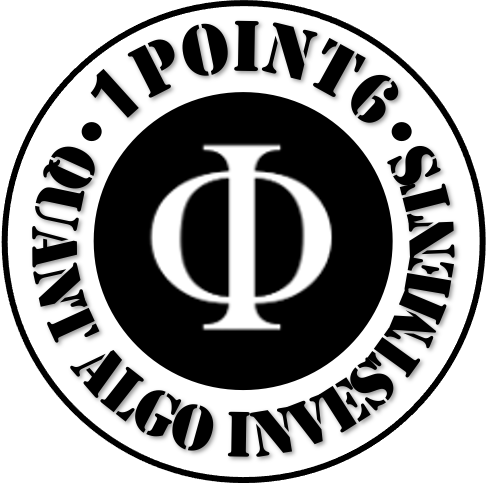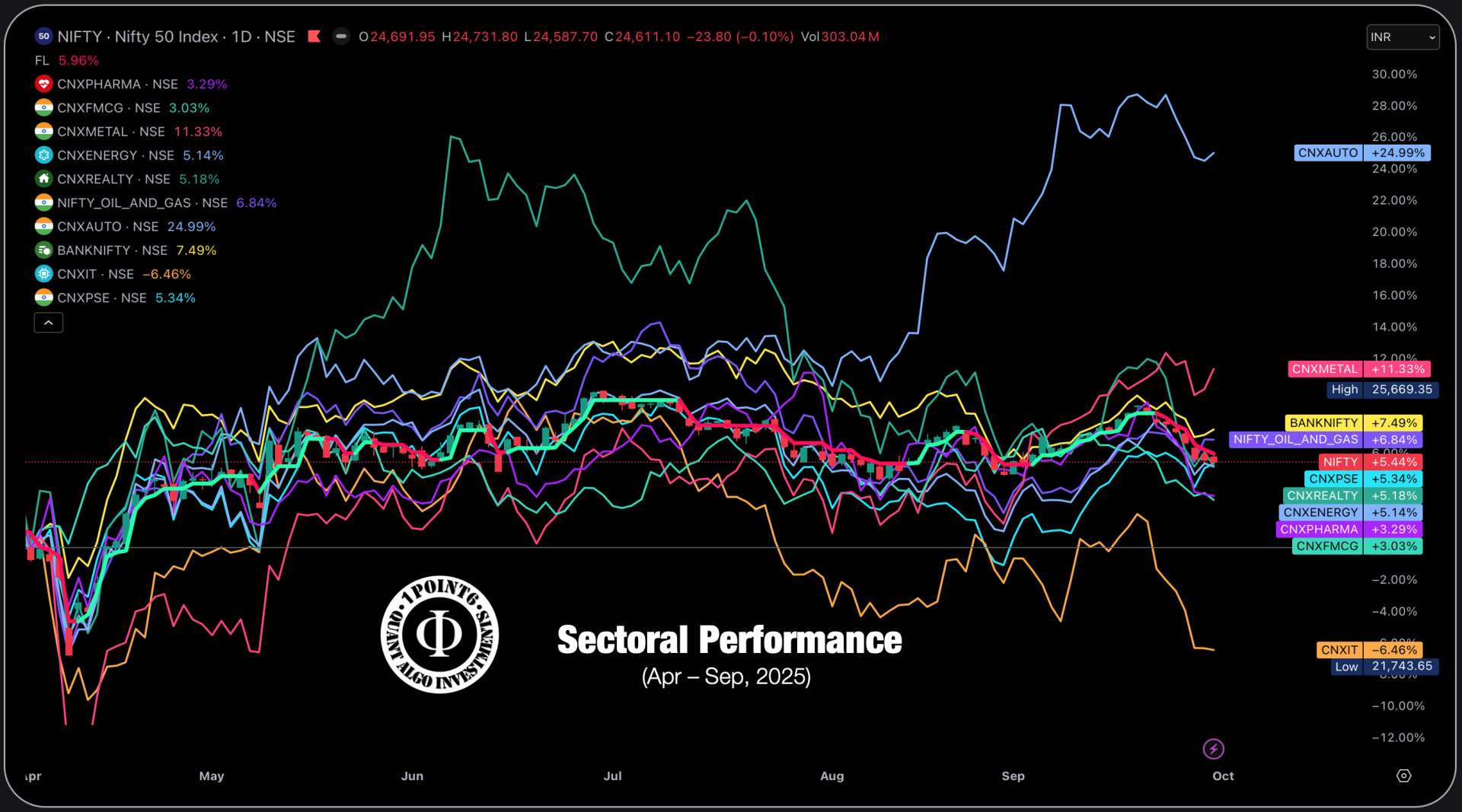𝚽 Sectoral Research
Explore 𝚽 Research for an in-depth analysis of sector performance trends. We examine historical data, uncover growth patterns, and identify key factors influencing each sector’s evolution over time.
Task
Comparative performance of NIFTY50 with industrial sectors like Auto, Banking, IT, Pharma, Oil & Gas and Energy.
-
Objective
Sectoral Performance
-
Strategy
Comparative analysis
-
Time Period
Apr - Sep (2025)
Sector vs NIFTY50 — Comparative Review (01 Apr 2025 → Now)
Below is a compact, publication-ready comparative analysis of the major Indian sector indices shown in your image, measured against the NIFTY50 for the period 01 Apr 2025 → now. I use the charted performance as the factual basis (sector returns shown on the image) and translate that into interpretation, key drivers and a short / medium-term outlook for each sector.
Benchmark: NIFTY50 = +5.4% (period).
(Where helpful I show relative performance = sector return − NIFTY return.)
Summary table — performance & relative strength (period)
| Sector Index | Absolute Return (%) | Relative vs NIFTY (%) | Interpretation |
|---|---|---|---|
| CNXAUTO | +25.0% | +19.6% | Clear outperformer / sector leader |
| CNXMETAL | +11.3% | +5.9% | Strong cyclical outperformance |
| BANKNIFTY | +7.5% | +2.1% | Financials showing outperformance |
| NIFTY OIL & GAS | +6.8% | +1.4% | Good participation, moderate leadership |
| CNXPSE | +5.3% | ~flat | In line with market, PSU/utility exposure |
| CNXREALTY | +5.2% | ~flat | Housing/infra-linked, market-aligned |
| CNXENERGY | +5.1% | ~flat | Domestic energy, in line with NIFTY |
| CNXPHARMA | +3.3% | −2.1% | Defensive, mild underperformance |
| CNXFMCG | +3.0% | −2.4% | Defensive muted gains, lagging NIFTY |
| CNXIT | −6.5% | −11.9% | Clear underperformer / sector laggard |
Interpretation: the period shows a rotation into cyclical, domestic-demand and commodity-linked sectors (Autos, Metals, Banks, Oil & Gas) while defensive sectors (FMCG, Pharma) posted modest gains and IT materially lagged.
Sector narrative, key drivers & outlook
CNXAUTO — Leader (+25%)
Why it ran: strong domestic buying, robust vehicle sales / replacement demand, easing supply-chain issues for parts, and likely positive earnings revisions for OEMs & ancillaries. Financing availability and festive season demand amplified flows.
Key drivers to monitor: monthly vehicle sales, dealer inventory, vehicle financing (EMI/loan growth), commodity costs (steel), and interest-rate moves.
Outlook: Near-term: constructive — momentum can continue if demand data and festive-season sales remain healthy. Medium-term: cyclicality remains — sensitive to rate shocks and any consumer credit stress.
CNXMETAL — Strong (+11.3%)
Why it ran: commodity-price strength (steel, base metals), inventory restocking, and domestic infrastructure/capex activity. Margins likely improved after prior weakness.
Key drivers: steel spreads, global commodity demand (China/EM), domestic infra announcements, import duty / trade policy.
Outlook: Positive but volatile — metals follow commodity cycles; a global slowdown or correction in prices could quickly reverse gains.
BANKNIFTY — Outperformed (+7.5%)
Why it ran: improving credit growth, better asset-quality trends, healthy deposit flows and expectations of loan demand pick-up. Financials picked up as cyclicals recovered.
Key drivers: bank credit growth, GNPA/slippage trends, interest-rate trajectory (deposit rates vs lending spreads), corporate capex data.
Outlook: Constructive if credit growth and asset quality continue improving; watch for policy / regulatory shifts and rate surprises that could change NIMs or borrower stress.
NIFTY_OIL_AND_GAS — Participated (+6.8%)
Why it ran: supportive crude/pricing environment and improved refining margins or marketing margins for integrated players. Energy names also benefit from domestic fuel demand and occasional policy tailwinds.
Key drivers: crude price direction, refining throughput & cracks, government fuel tax/subsidy changes, LNG/gas pricing reforms.
Outlook: Neutral-to-positive while crude and refining economics remain favorable; sensitive to sudden crude price moves or regulatory changes.
CNXPSE / CNXREALTY / CNXENERGY — Broad participation (~+5%)
Why they ran: steady gov’t capex talk, infrastructure activity, housing demand and steady energy consumption. PSEs also benefit from privatization / asset-monetization optimism where present.
Key drivers: government capex cadence, real estate sales/inventory trends, regulatory approvals, power/gas demand.
Outlook: Cautiously constructive — these sectors are tied to policy and budgetary flows; positive if capex continues, vulnerable to fiscal tightening.
CNXPHARMA & CNXFMCG — Defensive but muted (+3% each)
Why muted: defensive earnings and cash flows but limited excitement — margin pressure from input inflation for FMCG and regulatory/price pressure for Pharma. Investors rotated into higher-beta cyclicals.
Key drivers: input-commodity inflation (edible oils, packaging), pricing power, USFDA/other regulatory outcomes (pharma), rural consumption data (FMCG).
Outlook: Neutral — likely to outperform during risk-off episodes, but underperform during strong cyclical rallies.
CNXIT — Laggard (−6.5%)
Why it lagged: rotation away from growth/quality tech into value/cyclical names, possible translation headwinds from a stronger INR, and signs of softer global discretionary IT spend. Profit-taking and valuation resetting also factors.
Key drivers: large-client spending (North America & Europe), USD/INR moves, deal wins / large contract pipelines, margin commentary and visa/regulatory headlines.
Outlook: Cautious — recovery contingent on stabilization in global tech spend and positive guidance from big-cap exporters. Structural quality remains, but cyclical pain can persist.
Cross-sector themes & what’s driving the current market structure
Domestic demand re-rate: Autos + Banks + Realty participation signals stronger domestic consumption and financing confidence.
Commodity / capex influence: Metals + Oil & Gas strength suggests capex and commodity momentum — infrastructure and manufacturing appetite.
Risk-on rotation: Investors shifted from defensives & IT into cyclicals — typical when macro prints or earnings support domestic activity.
Macro sensitivity: Sectors are unevenly sensitive to RBI policy, crude and currency. That is why sectors like IT (exporters) and Pharma (regulatory/currency) behaved differently from cyclicals.
Risks that can reverse the current leadership
RBI hawkish surprise / higher real rates → consumer discretionary, auto and housing would weaken.
Global growth shock → metals and cyclical exports fall, IT could also suffer if corporates cut discretionary IT spends.
Sharp crude spike → inflation and input-cost pressure hits margins (FMCG, Airlines), but benefits some energy/refining names.
Regulatory/Trade actions → pharma inspections, trade barriers or import duty shifts can cause abrupt sectoral moves.
Tactical positioning & trade ideas (short / medium term)
Overweight: Autos, Metals, Select Banks — momentum + macro leverage. Favor cyclicals with strong balance sheets and visible earnings upgrades.
Neutral: Oil & Gas, PSE, Realty — keep exposure but be selective (names with structural cashflows).
Underweight: IT (until clearer demand recovery), select defensives only for tail-hedge (FMCG/Pharma) — rotate into them if risk-off arrives.
Hedge: Use index or options protection if you have large cyclical exposure (event risk: RBI, crude shock, global growth prints).
High-impact data/events to watch (will move sector leadership)
Monthly auto sales & two-wheeler/tractor reports — immediate read on Auto momentum.
Bank credit/deposit and large corporate borrowing trends — drives Banks.
Crude & steel prices / global PMI — direct for Metals, Oil & Gas and downstream cyclical margins.
RBI policy statements + inflation prints — affects consumption, rates and valuations.
USD/INR moves & large IT earnings/guidance — key for IT and Pharma translation.
Government capex announcements / realty approvals — matter for Realty, PSEs and Metals.
Practical conclusion (one paragraph)
Between 01 Apr 2025 and now the market rotated strongly into domestic cyclicals and commodity-linked sectors, with Autos and Metals the clear leaders and IT the pronounced laggard. That rotation reflects a view of improving domestic demand and capex/commodity tailwinds. Near-term the market remains bifurcated — overweight cyclicals but keep protective hedges and watch RBI, crude, currency and monthly demand indicators closely. If domestic data continues to surprise positively the cyclical leadership can extend; if macro/inflation or global growth deteriorates, flows will likely revert to defensives and IT.

